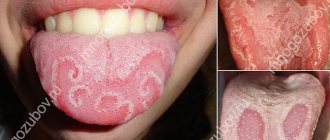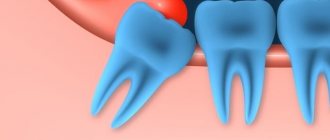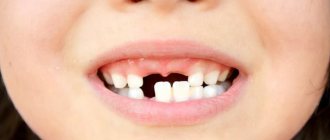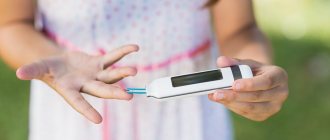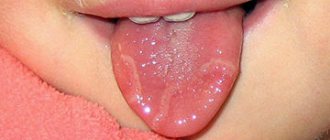Causes of the smell of acetone from the mouth of a child
Acetone syndrome is a condition of the body characterized by the presence of excessive amounts of ketone bodies in the blood.
This syndrome can be either a separate disease or occur in various diseases. The main signs of acetone syndrome include nausea, vomiting, lack of appetite and cramping abdominal pain. The syndrome most often occurs before the age of 12, with girls suffering from the disease much more often. Read on to learn how to treat increased acetone in children.
Pediatricians distinguish between idiopathic (primary) syndrome, which is an independent disease, and secondary, which accompanies the underlying disease. The latter include diabetes mellitus (most often a decompensated form), hemolytic anemia, thyrotoxicosis, traumatic brain injury, toxic liver damage and others. The course of secondary acetone syndrome and its prognosis largely depend on the course of the underlying disease.
Causes of acetone odor from a child’s mouth:
- lack of carbohydrates in the diet;
- disturbance of acid and water-electrolyte balance in the body;
- abuse of fatty and protein foods;
- strict diet or prolonged fasting;
- excessive physical activity;
- depletion of pancreatic reserves.
Calendar of events:
- 19Nov
All-Russian conference “Life with diabetes from 0 to 100” ending date: November 20, 2021 Venue: OnlineRead also: Why you can't hold back your sneeze
- 30November
Integration summit “World-class scientific centers (NCMC) in the field of healthcare” end date: November 30, 2021 Venue: Moscow, congress center of the First Moscow State Medical University named after. THEM. Sechenov, st. Trubetskaya 8 - 30Nov
Third annual conference “What’s happening in the dietary supplement market?” End date: November 30, 2021 Venue: Moscow, Hilton Moscow Leningradskaya/online - 02Dec
Congress on Molecular Immunology and Allergology IMAC 2021 closing date: November 03, 2021 Venue: Moscow/onlineRead also: Why is the ruble “cheaper” than the hryvnia? —
- 04Dec
I Annual International Congress “Chazov Readings” together with the VII Conference “Cardiovascular Pharmacotherapy” End date: December 04, 2021 Venue: Online
Symptoms of the disease
This condition is characterized by the appearance of frequent acetonemic crises, the first of which occur at the age of two to three years. Symptoms of an acetone crisis include:
- repeated vomiting, diarrhea, temperature rises to 38°C;
- smell of acetone from the mouth;
- lack of appetite;
- primary excitement followed by drowsiness and apathy;
- arrhythmia, pale skin, unhealthy blush;
- cramping abdominal pain;
- intoxication and dehydration (dehydration).
Let us remind you that it is extremely important for parents to know what to do in case of acetonemic vomiting in a child.
Risk factors
Risk factors for the appearance of an acetone odor are noted, such as infectious diseases with a significant increase in temperature, persistent infections, helminthic infestation, and stress conditions. At a young age, a risk factor is also poor nutrition in children with a lack of the required amount of carbohydrates. Ketosis can be triggered by consuming large amounts of fat, as well as physical overload. It should be borne in mind that the trigger for the development of autoimmune diabetes mellitus in children can be the frequent use of corticosteroids (negatively affecting the adrenal cortex) and antiviral agents containing recombinant interferon alpha-2b. [5], [6], [7]
Diagnosis of the syndrome
To make a correct diagnosis, anamnesis data, patient complaints, clinical manifestations and the results of additional examination are important.
Laboratory tests include a biochemical blood test and a general urine test. Please note that the amount of acetone in children who do not suffer from this disease does not exceed 0.01 grams.
Instrumental diagnostics is echocardioscopy, with which you can see indicators of central hemodynamics. Acetone syndrome is characterized by a decrease in the diastolic volume of the left ventricle and a decrease in venous pressure. Against this background, the cardiac index is increased due to tachycardia.
Recently, you can even test your urine for acetone at home. For this purpose, special indicator test strips are used.
On our website you can familiarize yourself with the qualifications of specialists advising on this issue and learn how to check the level of acetone in children.
Complications and consequences
Type 1 diabetes mellitus often occurs in childhood and can be complicated by episodes of diabetic ketoacidosis, a severe state of absolute or relative insulin deficiency leading to hyperglycemia, hyperacetonemia, and systemic inflammation. Possible consequences and complications of this condition in children include disruption of acid-base homeostasis: the level of ketones also increases in the urine (which is defined as ketonuria), and along with their excretion during urination, the level of electrolytes (K and Na ions) in the plasma decreases. Cerebral edema (about 1% of cases), acute ischemic or hemorrhagic stroke, pulmonary interstitial edema and coagulopathies (due to impaired clotting factors) are also possible. In addition, as with any increase in blood acidity, the endothelium of blood vessels may suffer: oversaturation of the blood with ketone bodies increases the negative impact of free radicals on cells and leads to oxidative stress. It is believed that ketones, or rather their increased levels, are related to the occurrence of cancer pathologies. In acetonemic syndrome, there is a possibility of liver enlargement and fatty infiltration, and in severe acetonemic crises, the risk of coma and death cannot be excluded. [10], [11], [12]
Therapeutic measures
At the first signs of the syndrome in question, the child should be reassured and given glucose. The use of a sorbent is also extremely important - it can be enterosgel or even activated carbon. To avoid dehydration, drinking plenty of fluids (mineral water) is recommended. It should be given one tablespoon at a time, but often. The use of antispasmodics is justified.
If vomiting does not stop within an hour, you must call an ambulance, which will provide qualified first aid for acetone in children.
In case of secondary acetone syndrome, treatment of the underlying disease is important.
Who is at risk
There is a category of children who have a high probability of developing acetone syndrome. Signs of such children:
- Gender Female;
- age 2-7 years;
- thin body build and slight underweight;
- increased curiosity and good learning ability;
- excellent memory;
- stubborn character;
- poor appetite;
- irritability and sleep disturbances, increased tearfulness.
Such children begin to talk early. By about 12-13 years of age, the tendency to have crises gradually disappears. Until this point, parents should always keep appropriate medications, mineral water and test strips in the house.
To minimize the possibility of acetone accumulation in the body, you need to create an environment favorable for the child’s development. He must eat right, develop mentally and physically, but not overwork and not experience constant stress. It is also important to have regular checkups with your doctor to avoid sudden deterioration in your health.
Diet with acetone in children
One of the main causes of acetone syndrome is poor nutrition. To avoid relapses, we advise parents to strictly monitor the baby’s daily diet. Carbonated drinks, chips, sweets with preservatives are strictly prohibited. Also, do not give your child fried or too fatty foods. The diet should be dominated by porridge and vegetable soups. Meat and herbs are added in small quantities. Following a diet with acetone in children is of great importance. As a rule, doctors recommend sticking to it for two to three weeks after a crisis of acetone syndrome.
The key to fresh breath is hygiene
It is imperative to pay attention to the condition of the oral cavity. Maybe the child is too lazy to brush his teeth, or he does it just for show, without thoroughly cleaning the gums and interdental space. Therefore, in this case, it is possible that the baby has developed and is developing caries, and the appearance of the smell is connected precisely with this.
You need to take care of your oral cavity as soon as your baby gets his first teeth. Colonies of pathogenic microorganisms develop well in a poorly cleaned oral cavity.
Take a good look at the condition of the oral mucosa - mothers are sometimes able to detect signs of stomatitis or other inflammations.
There can be a lot of food debris left on the mucous membrane of the tongue and parents should not forget about this. Very young children need to regularly clean their tongues of plaque; as they grow older, you need to teach them to do this on their own.
How to reduce acetone in a child: tips for parents
As noted above, at the first signs of an emerging crisis, it is important to give glucose preparations and cleanse the intestines. For this purpose, you can do an enema with a soda solution, give a sorbent and give the baby small portions of water. Your local pediatrician will tell you in more detail how to reduce acetone in a child.
A list of easy-to-follow recommendations that will help prevent relapse:
- normalization of the daily routine;
- eliminating excessive loads;
- limiting time for watching television programs and computer games;
- proper nutrition excluding processed foods, fast food and quick snacks;
- walks in the air and moderately active games;
- adequate day and night sleep.
In addition, parents should know the dangers of increasing acetone in children and what its consequences are.
Forecast
If treatment is started on time, the prognosis for this condition is favorable. Timely consultation with a specialist, high-quality diagnosis and effective therapy will help avoid many serious complications. To a greater extent, this statement concerns the first (idiopathic) syndrome.
If you have any questions regarding acetone syndrome in children or need help from a specialist, we are always happy to help. The medical center is equipped with modern equipment. The appointments are conducted by doctors with many years of experience. The specialist will carry out diagnostics, tell you about the first symptoms of increased acetone in the child’s urine and about methods of prevention. Contact us - we can help you 24 hours a day.
Related services: Pediatrician consultation
What to do?
Do not panic! Responsibility for the condition of the child lies only with you!
So, the child is nervous, hungry, and has a smell of acetone on his breath - give him a sweet drink, give him some sweets. Coca-Cola is best, because this drink has a lot of sugar and the child will drink it with great pleasure. This category also includes various sweet lemonades and sodas.
Do not put your child on a diet, especially a hungry one, especially one without sweets. This can make the situation worse. Don't limit your child's sweets! It is necessary to ensure that the distance between meals for the child is at least 4 hours.
It is also important to remember that stress in a state of acetonymia is contraindicated, just like a sharp increase in physical activity. You should always carry 40% glucose and candy with you.
If you doubt that your child has acetone, buy special test strips to determine it in urine. These are paper strips with a reagent that changes color depending on the acetone content in the urine.
If the child’s condition is more severe, then it is necessary to start giving him a sweet drink; in this case, saline solutions will only help against dehydration, but will not affect his well-being. But you can give a saline solution in parallel with sweets.
Sometimes it happens that if there is severe vomiting, it is impossible to give the child a sweet drink. In this case, glucose is administered intravenously or an injection of an antiemetic is given, and while it is working, this is about 2-3 hours, you need to let the child drink as much sweet liquid as possible.
If the condition does not improve, vomiting does not stop, and signs of dehydration appear, call an ambulance, as in this case infusion therapy is needed. As soon as the acetone crisis has passed, you just need to forget about it. Do not torment your child with diets, do not look for reasons, but simply live and do not forbid your child sweets, because in 100% of cases children outgrow this condition.
The main thing is to know how to provide first aid and not to scare the child with hospitalization. Of course, there are situations when a hospital cannot be avoided, for example, when intoxication and dehydration of the body are too severe, then the introduction of glucose through a vein is inevitable, but such conditions are very rare and most often we can cope at home ourselves.
It is worth remembering that this condition can develop in an absolutely healthy child, and acetone syndrome without other signs most often does not mean the presence of diabetes. But if acetone appears in a child often for no reason and is accompanied by sudden weight loss, the child often urinates and is constantly thirsty, then it is worth checking for type 1 diabetes.
Preparing a saline solution for dehydration
A treatment method aimed at introducing fluid into the body is called rehydration therapy. Rehydration is, in fact, the replenishment of fluid losses. There are two main methods of rehydration - intravenous, when the necessary solutions are injected into a vein through a dropper, and oral - when a person receives the necessary solutions through the mouth.
What it is? Sometimes it is a ready-made solution, but usually it is a powder, or tablet, or granules, which contain the sodium, potassium, chlorine and other substances necessary for the body in specially selected combinations and concentrations equivalent to pathological losses. Let me explain: sweating is a loss of not only fluid, but also sodium and chlorine (after all, sweat is salty, and everyone probably remembers the school formula NaCl). If you replenish fluid losses, but do not replenish salt losses, this is fraught with serious problems. How much salt do you still need? So smart scientists calculated the optimal amount of salts for a certain volume of water.
The formulas for rehydrating agents are based on these calculations. In addition to salts, the preparations often contain glucose; sometimes extracts of medicinal plants (chamomile extract, for example), and decoctions of cereals (rice, wheat, etc.) are added.
Oral rehydrating agents are an ideal option for quickly and effectively replenishing physiological and pathological fluid losses.
This is why oral rehydration products are over-the-counter medications.
That is why oral rehydration products should be an essential component of a home first aid kit.
